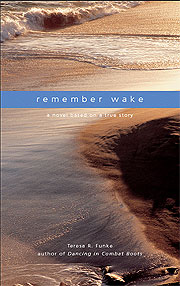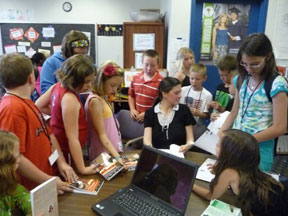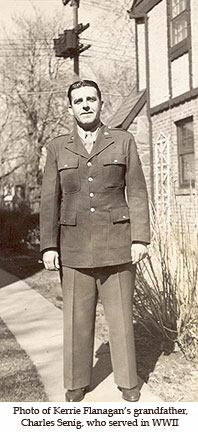Teresa Funke has carved a niche for herself and her books, bridging the gap between World War II and the present. During this war, everyone, including the women and children, worked hard to support the military and to keep this country going. Teresa shows this same drive and dedication with her writing and with her passion of preserving the stories from this time in our history.
Through her own publishing company, Victory House Press, she specializes in historical fiction and created the award-winning Home-Front Hero series for children, as well as two books for adults—Dancing in Combat Boots, a collection of short stories based on real women, and Remember Wake, about the attack and seizing of Wake Island.
But she has even taken that a step further with her Do Your Part School Kit Program, where individuals or businesses can sponsor a kit for a school and at the same time, honor someone they know who served in World War II. The kits get sent free of charge to a school of the sponsor’s choice or the next one in line on the list, and the sponsor has the option of submitting a 300-word story and photo of a person who served during the war. The stories and photos of these Kit Honorees are highlighted on the website and are also included in the kit, so the kids can connect history to real people.
Teresa is an inspiration and role model to all writers who want to make a difference in this world with their writing.
***
WOW: How did your passion for World War II begin?
Teresa: I have a history degree from Boise State. I had been working for a PBS series and was sent to interview Clint Haakonstad, who later inspired my book, Remember Wake. When I went out to do that interview, I was shocked that here was a guy in town who’d gone through something that I hadn’t heard of as a history major. A lot of the Wake Island men were located in Bosie, and they had this amazing story.

I also kept thinking about Clint’s wife who sat next to him during the interview, and she knew everything. She would tell him, “Don’t forget to tell her this, and don’t forget to tell her that.” She kept all his scrapbooks, and I got to wondering about her story.
So I went back and did an oral history of her to find out what happened to the women who were married to the Wake Island men. I found out it was a completely unique experience for those women. Because the men were civilians, they couldn’t find out if the men were alive for the whole war, and the women didn’t get any support from the government. I decided to write a book about this.
WOW: After writing and publishing Remember Wake, what inspired your next book, Dancing in Combat Boots?
Teresa: When I was researching Remember Wake, I had a really hard time finding information about what it felt like to be a woman during the war. Not statistical information, but what did everyday women do during the war, what did they feel like, and what did they worry about? It wasn’t out there. I wanted to write that book.
I went out and interviewed women around the country with different backgrounds and different socioeconomic groups and different ethnic groups, and had them tell me what it was like being a woman during World War II. These were not the typical Rosie the Riveter stories or the stories about the nurses. These were stories about the things you never knew women did during World War II.

“I would go into these classes (mostly fifth grade) and found that these kids had never heard of Pearl Harbor, they had never heard of Hitler, and they had no idea whom we fought during World War II.”
(Photo from Teresa’s website: Summer Reading Program at the Boys and Girls Club)
WOW: That’s great that you took the time to preserve this part of history that many of us have no idea about. So then, how did this all transition in writing books for children?
Teresa: I was thinking about doing a sequel to Remember Wake, and around the same time, I started getting invited to go into classrooms to speak to kids about writing and World War II. But I would go into these classes (mostly fifth grade) and found that these kids had never heard of Pearl Harbor, they had never heard of Hitler, and they had no idea whom we fought during World War II. I kept looking at them and thinking: You’ve never heard of Adolf Hitler? How can this possibly be? I would look at the teachers, and they’d shrug and tell me it’s not in the curriculum.
On different occasions, kids would give up their recess to hear me keep talking. I realized this is something they really want to know about and a time period that really engages them. So it was the kids who said, “Why don’t you write something for us? We want to read more about the war, and there really aren’t any books for us to read about it.”
This inspired me to want to write a series of books based on real people that I’d interview. Each book would be a slice of life of an American child on the home front, it would be multicultural, and there would be six books in all. So, the Home-Front Heroes series was born.
The first book is about a fourteen-year-old girl who works in the war factory in the Illinois valley. The second book is the Japanese internment camp story about a boy in Tule Lake California. The third book is about a Mexican-American boy in San Antonio, who helps in the family store. The fourth book is about a Jewish girl in the Bronx, who befriends an English evacuee. The fifth book is a Pearl Harbor story, and the sixth book revolves around an African-American character. I haven’t quite figured out the whole angle for that yet.
WOW: Are all the books available?
Teresa: The first three are done and the fourth one will be out in December.
WOW: Is there anybody in your family who was in World War II?
Teresa: No, my grandparents were all here, and my grandmother worked in a war factory in Detroit. She went from San Antonio to Detroit. My two grandfathers had jobs here. It is not a family thing; although the third book, V for Victory, is based loosely on my mother’s family in San Antonio. They owned the stores, and the main character is actually based on my uncle.
“People who were children during the war are now in their mid-eighties. So in time, I will be forced to stop because everything I do is based on real people.”
WOW: You have found a great niche and clearly a great passion for World War II stories. Do you plan on writing books on other topics besides World War II?
Teresa: I plan to down the road; but since all of my books are based on real people and on saving these untold stories about the war, I am kind of committed to that until I don’t have the people to tell me those stories, which is coming up quick. People who were children during the war are now in their mid-eighties. So in time, I will be forced to stop because everything I do is based on real people.
WOW: How did the school kits emerge?
Teresa: When I started talking to these teachers and saying, “Look how interested these kids are in this time period. Isn’t there any way you can teach this to the kids?”
They told me there really wasn’t because it wasn’t in the curriculum. That bothered me that kids weren’t going to learn about an important time period in our history. They do learn about it in eighth grade; but by the time kids are fourteen, they have already decided that history is boring. But when you get them at fourth or fifth grade, they are still fascinated and curious about everything. Then when they come back to World War II later, they will be really interested.
I had the books already. So I asked some teachers, “What if we created some curriculum that allowed you to teach it in the classroom? Would you teach it then?” Then they said, “Of course!”
I hired a teacher who was a curriculum specialist to develop the curriculum. We designed it, so teachers could teach it in their language arts, reading incentives, or history programs. So now they had a way to teach World War II in the classroom; but to fully benefit from this, we wanted to make sure they had the books as well.

I never do anything in my business that isn’t a win, win, win for everybody. In this case, I knew budgets were down, and it was not in the curriculum. I came up with the idea of finding sponsors to pay for these classroom sets and the curriculum to give to the teachers for free, and all teachers had to do was just sign up. The sponsors get to donate a classroom set for a minimal amount of money and donate it in honor of somebody from the World War II generation. This fulfilled my mission of saving those stories because sponsors send us the information about the person, we print a flyer, the flyer goes to the kids, so they can learn about a real person from World War II, and we put the flyers up permanently on my website. The families of the person being honored also get copies of the flyers.
For me, it was an incredible idea because I got to preserve World War II history, and I got to show kids that these are everyday heroes, not famous people, that we are honoring with these kits. Then the teachers got classroom sets of thirty books, which they were completely excited about because they rarely get classroom sets of books. The students get to learn about World War II through books they really enjoy, the sponsors get to donate to a school, and I get some business out of it as well.
WOW: How long did it take you to put this program together?
Teresa: It took us about a year to work out the kinks in our system. It is a time-consuming process. We have to deal with shipping, tax issues, and making the connections between the sponsors and the school. I tested this idea in two markets—one in Colorado and the other in Boise. And in one day, thirty-five teachers in Boise signed up. The same thing happened in Colorado. I took the flyers to a teachers’ convention; and in one week, we had forty-five teachers sign up. It showed me there was a definite need for something like this.
WOW: How does the sponsorship work and what are the costs?
Teresa: The program was set up so a business, individual, or a civic group could donate the kits. The cost of the Classroom Kit is $325, and the class gets thirty copies of one book or fifteen copies of two different books. The Reading Book set is $125 and has ten books. Each kit includes sixteen student activities and the five-page lesson plan specific to the book. They also get a gift from me and a flyer as well.
Sponsors can choose if they want to purchase a kit for a specific school, or one in their home state, or the school that is next on the list. We have about half our sponsors say, “Give it to the next school on the list,” and half our sponsors want to give it to a particular school, and some will say something like they want it to go to a Denver area school.
WOW: Do you ever have sponsors deliver the kit directly to the classroom?
Teresa: I always recommend that if sponsors can they deliver the kit themselves. If they are in the area, I try to go with them. The teachers are always willing to have them come. Then we ship the kits to the sponsor, and the sponsor goes into the classroom. They give the kit to the kids, and they tell them the story behind the person they are honoring with the kit. The kids love it.
We had one guy in Oklahoma, whose dad was almost ninety, and he had a grandson out in Oklahoma. They flew the granddad out there to visit the family and to go to the school. The principal was so excited that she brought all the kids in, and he spoke to a gym full of kids. At his age, he is probably not going to get the opportunity to do that again. I love that connection when it happens.
WOW: So how is the program doing? How many kits have you distributed?
Teresa: We’ve placed over seventy kits in eleven different states. We still have fifty teachers on the waiting list.
WOW: What is your ultimate dream for the school kits?
Teresa: I would love to get the kits into all fifty states.
There are so many lessons to learn from World War II. This was one of the most critical time periods in our history to be a child. In the back of every book, it tells them what they would have done if they were a child during World War II. They would have done victory gardens and war bond drives and met the troop trains and collected scrap metal and wrote letters to the soldiers. There were dozens of things kids did to help us win the war.
When I go in and talk to kids, they are riveted by the thought that they could have ever been that important and that we could have ever asked that much of kids. For me, the glory of the school kit program is it provides a way for teachers to get that education to that age group, it gets the books in the classroom without having to worry about the budget, it provides a way for kids to learn about this important time period in history in a way that is really fun, and it honors the people who served our country during that time.
***

Kerrie Flanagan is a freelance writer, writing consultant, and director of Northern Colorado Writers. Her 130+ articles can be found in various national and regional publications. You can read her blog at https://www.the-writing-bug.blogspot.com or visit her website at https://www.kerrieflanagan.com.
To learn more about NCW, visit:
https://www.NorthernColoradoWriters.com
-----
Enjoyed this interview? Check out more interviews by Kerrie on WOW!:
From Book to Big Screen: Interview with Screenwriter Robin Swicord
Writing a Strong Story: Tips from the Pros